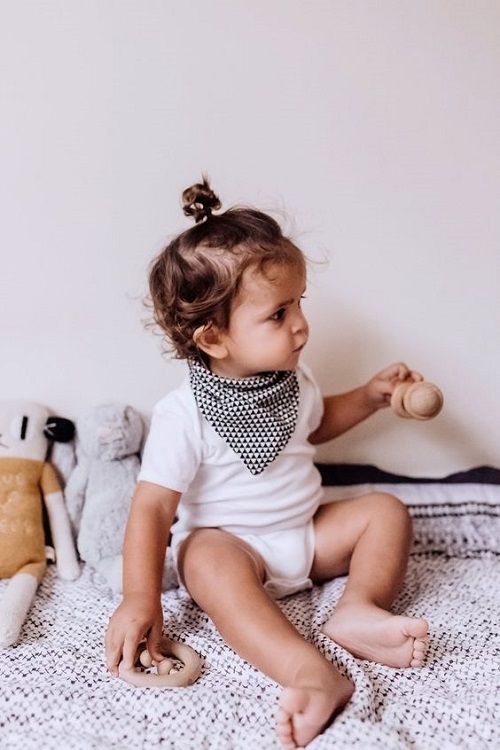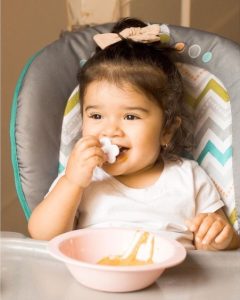Feeding bibs are more than just adorable accessories; they’re a parent’s secret weapon against food splatters, spills, and drool. Essentially, a feeding bib is a protective garment that covers your baby or toddler’s chest and neck during mealtimes. They come in various materials, styles, and sizes, each with its unique advantages.
Why Feeding Bibs Matter:
Mess Management:
Feeding bibs act as a barrier between food and your little one’s clothes, preventing stains and making cleanup a breeze.
Hygiene:
Bibs can help protect your child’s delicate skin from food irritations and keep them clean during messy meals.
Independence:
As your child grows, bibs can encourage self-feeding and foster independence at mealtimes.
Style and Fun:
Feeding bibs come in a wide array of colors, patterns, and designs, adding a touch of personality to mealtime.
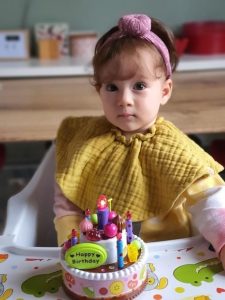
Types of Feeding Bibs: Exploring Your Options
Feeding bibs come in various styles, each catering to different needs and preferences:
- Drool Bibs: Perfect for teething babies, drool bibs are usually made of absorbent materials like cotton or terry cloth to soak up drool and keep your little one’s skin dry.
- Feeding Bibs: Designed to catch food spills, feeding bibs are often made of waterproof or water-resistant materials like plastic, silicone, or laminated cotton. They may have pockets or crumb catchers to trap food that doesn’t make it into your child’s mouth.
- Sleeved Bibs: Ideal for messy eaters, sleeved bibs offer full coverage, protecting both your child’s clothes and arms from food splatters.
- Disposable Bibs: Convenient for travel or on-the-go meals, disposable bibs offer a quick and easy solution for mess containment.
- Smock Bibs: These larger bibs cover more of your child’s clothing, making them perfect for art projects or other messy activities.
Choosing the Right Material:
- Plastic or Silicone: These materials are easy to wipe clean and are ideal for containing wet or sticky messes.
- Cotton or Terry Cloth: These absorbent materials are perfect for catching drool or wiping little faces.
- Laminated Cotton: Offering a combination of absorbency and water resistance, laminated cotton bibs are a versatile choice for everyday use.
When choosing a bib, consider your child’s age and size. Most bibs come in various sizes, from newborn to toddler. Ensure the bib fits snugly around your child’s neck without being too tight.

Closure Options:
- Velcro: Easy for parents to adjust, but toddlers may learn to undo it.
- Snaps: Secure and difficult for little hands to undo.
- Ties: Offer a more customized fit, but can be time-consuming to tie and untie.
Features to Consider: Functionality and Convenience
Feeding bibs come with a range of features to enhance functionality and convenience:
- Pockets or Crumb Catchers: Help to catch spills and make cleanup easier.
- Adjustable Necklines: Allow for a customized fit as your child grows.
- Waterproof or Water-Resistant Materials: Protect clothing from stains and moisture.
- Machine Washable: Simplify cleanup and ensure hygiene.
- Roll-Up Design: Make bibs easy to store and transport.
- Fun Designs and Patterns: Keep your little one entertained during mealtime.
Choose bibs made from non-toxic materials that are free of harmful chemicals like BPA, PVC, and phthalates. Avoid bibs with small buttons or embellishments that could pose a choking hazard.
Caring for Your Feeding Bibs
Proper care will ensure your bibs stay clean and hygienic:
- Wash Regularly: Wash bibs after each use, following the care instructions on the label. Most bibs can be machine-washed or hand-washed.
- Stain Removal: Treat stains promptly with a gentle stain remover or by soaking the bib in a mixture of water and baking soda.
- Drying: Air dry bibs whenever possible to prolong their lifespan and prevent shrinkage.
Let me know if you’d like any more sections.
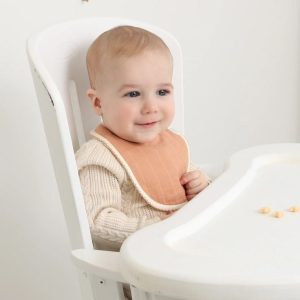
Fashionable Bibs: Style Meets Function
Gone are the days of boring, plain bibs! Today’s feeding bibs are available in a wide variety of fashionable designs that complement your child’s outfit and personality.
- Trendy Prints: From adorable animals to playful polka dots, bibs with trendy prints add a touch of fun to mealtime.
- Embroidered Details: Delicate embroidery or appliqué designs add a touch of sophistication and elegance.
- Bandana Bibs: These trendy bibs not only catch spills but also add a stylish flair to your baby’s outfit.
- Personalized Bibs: Add your child’s name or initials to a bib for a personalized touch.
Don’t be afraid to treat bibs like any other accessory. Choose bibs that coordinate with your child’s outfits, creating a stylish and cohesive look.
Feeding Bibs for Special Occasions
Feeding bibs aren’t just for everyday use. Elevate your child’s special occasion attire with these options:
- Formal Bibs: Made from luxurious fabrics like silk or satin, formal bibs add a touch of elegance to christenings, weddings, or holiday gatherings.
- Holiday-Themed Bibs: Celebrate special occasions with bibs featuring festive designs like pumpkins for Thanksgiving or snowflakes for Christmas.
- Birthday Bibs: Commemorate your child’s birthday with a bib featuring their age or a fun birthday message.
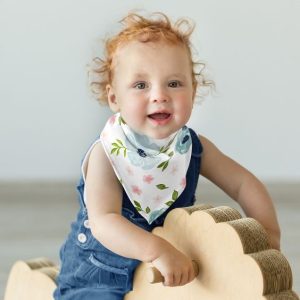
Feeding bibs make thoughtful and practical gifts for baby showers, birthdays, or holidays. Consider personalized bibs or a set of bibs in different styles and materials.
DIY Feeding Bibs: Crafting Your Own
If you’re feeling crafty, try your hand at making your own feeding bibs. You can customize them to your child’s specific needs and preferences.
- Fabric Choices: Use soft, absorbent fabrics like cotton flannel or terry cloth.
- Patterns and Tutorials: Find numerous patterns and tutorials online for sewing your own bibs.
- Upcycling: Repurpose old towels, t-shirts, or other fabrics into unique and eco-friendly bibs.
Add decorative stitching, appliqués, or embroidery to personalize your handmade bibs.
Beyond the High Chair: Bibs for Every Adventure
Feeding bibs aren’t just for mealtime. They can also be useful for:
- Teething: Drool bibs help keep your baby’s clothes dry and protect their skin from irritation.
- Arts and Crafts: Smock bibs protect clothing during messy art projects.
- Outdoor Play: Waterproof bibs keep your child clean during water play or messy outdoor activities.
- Travel: Disposable bibs are convenient for on-the-go meals and cleanup.
Use bibs with fun patterns and textures to stimulate your child’s senses and encourage exploration.
Feeding Bibs: A Practical and Stylish Choice
Feeding bibs are an essential item for any parent of a baby or toddler. They make mealtimes less messy, protect clothing, and offer a fun way to express your child’s personality. With so many styles, materials, and features to choose from, you’re sure to find the perfect bibs for your little one’s needs.
